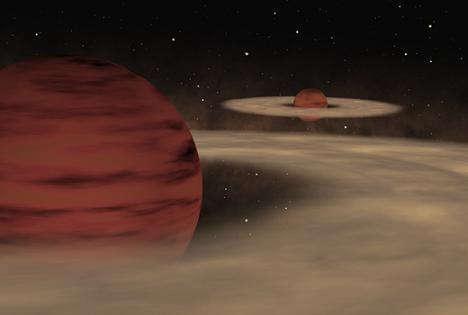A pair of strange new worlds that blur the line between planets and stars have recently been discovered outside the solar system. So far, about half a dozen of these bodies have been identified, but this is the first time that twins have been discovered - such bodies that orbit each other without also orbiting a star. These bodies are called planemos

A pair of strange new worlds that blur the line between planets and stars have recently been discovered outside the solar system. So far, about half a dozen of these bodies have been identified, but this is the first time that twins have been discovered - such bodies that orbit each other without also orbiting a star.
These bodies are called planemos (planemos) their existence challenges the theories about the formation of planets and stars, astronomers claim in the journal Science.
"This is an impressive pair - with each of them having a mass of about XNUMX percent of that of the Sun" says Ray Jayawardena from the University of Toronto, co-author of the scientific article. "Their existence is a surprise and their origin and fate is still a mystery." added
double planet
The pair belongs to a new group of planet-like objects floating in space. They are called objects with planetary mass (planetary mass objects) or for short palanmos, which are not bound by gravity to any star.
They appear to have emerged from a cloud of gas that contracted in a similar way to star formation, but they were too cold to become true stars. While their mass is similar to that of many of the giant planets discovered beyond the solar system (the largest of which is 14 times the mass of Jupiter and the others are mostly around seven Jupiter masses), they cannot be considered planets. "We resist the temptation to call this pair a "double planet" because they did not form the way the planets in our solar system were formed," said researcher Valentin Ivanov, from the European Southern Observatory in San Diego, Chile, and a partner in the study.
“amazing variety”
The two objects are similar in their color and the light emitted from them, and this indicates that they were created at the same time, about a million years ago. The distance between them is six times the distance between the Sun and Pluto, and they were discovered in the Ophiuchus star formation region about 400 light years away from us. Their official names are Oph 162225-240515 or Oph 1622 for short. The other discoveries revealed a large variety of worlds,” said Jayaonardhana. "Still the pair of 1622 is one of the most unusual if not one of the strangest." said. His colleague, Ivanov, said that they are curious to find out whether such pairs are common or rare in the universe. "The answer could shed light on the question of how planetary-mass objects that are not part of the solar system formed."
The pair was discovered using the state-of-the-art telescope at the European Southern Observatory in La Silla, Chile, and follow-up studies were carried out using ESO's Very Large Telescope at the same site.
